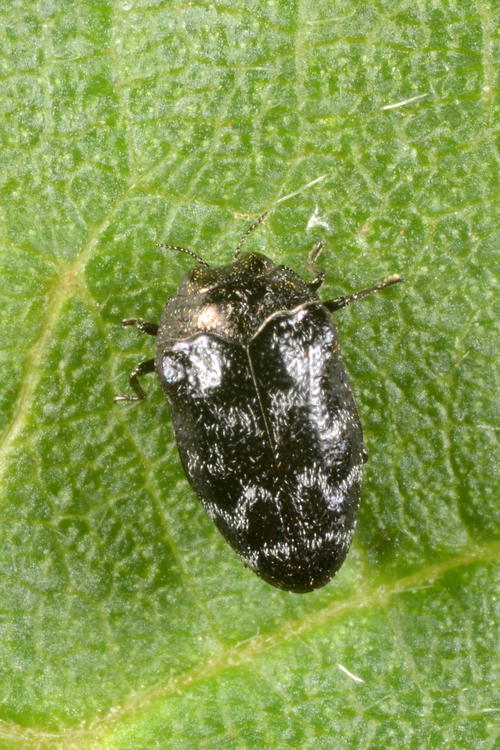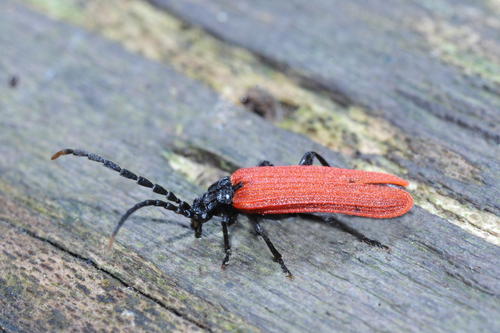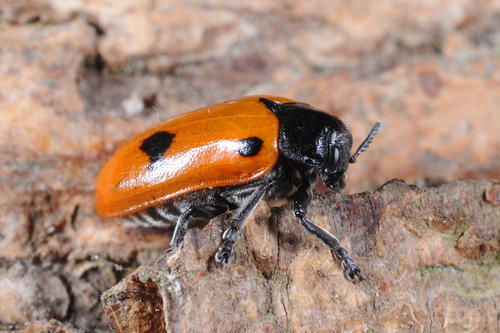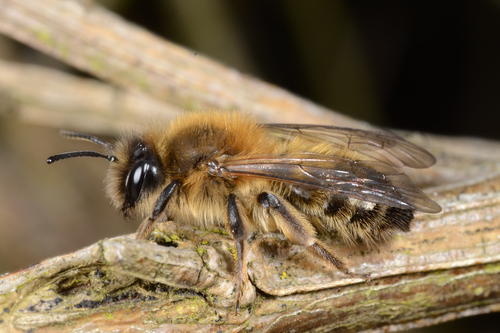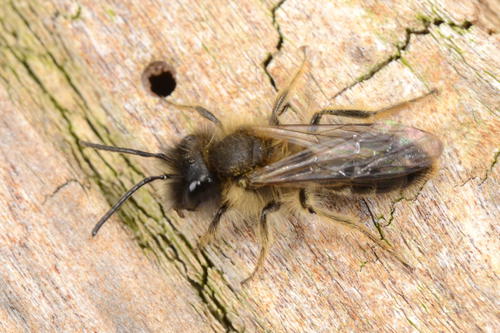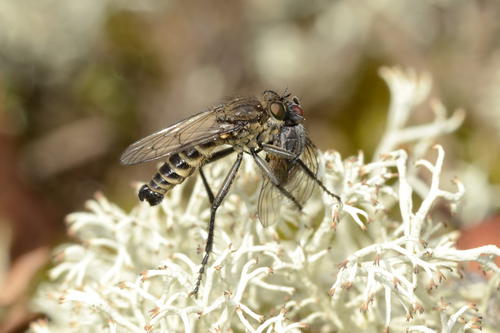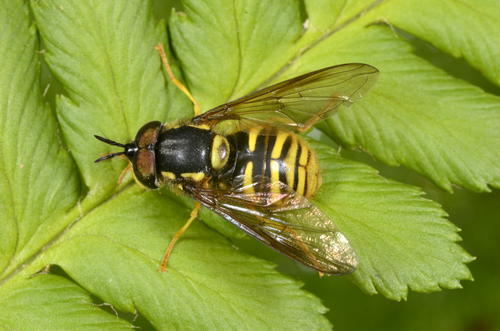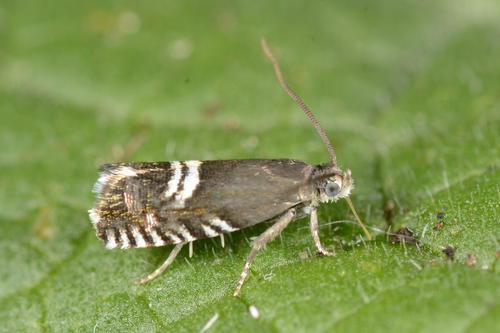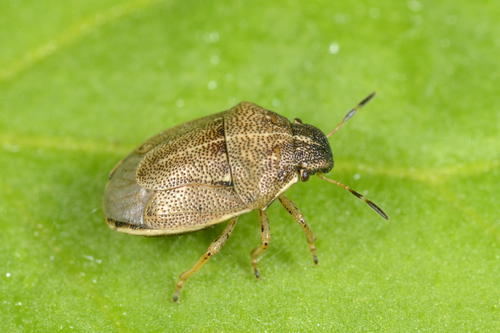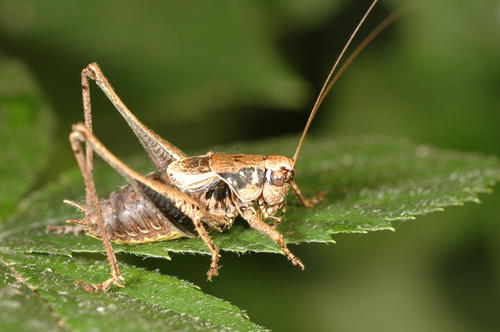Invertebrate Records from Worcestershire
John Bingham
[Correction: original reference to Trox scaber, (Linnaeus, 1767). Coleoptera: Trogidae (Fig. 01. deleted) was in error.]
Trachys minutus, (Linnaeus, 1758). Coleoptera: Buprestidae RDB2 and LBAP
This small beetle (3-4mm) was found on 26 August on a small-leaved lime leaf at Shrawley Wood. The tree was next to an open glade area and was in full afternoon sunlight. The female beetle lays eggs on the leaves of deciduous trees, normally sallow, hazel or elm. The larvae eat the green tissue between the upper and lower layer of the leaves, making blotch mines on the edge of the leaf. It may use lime tree leaves at Shrawley, as this is also quoted as a food plant for the larvae. See Web pages: 'the leaf and stem mines of British flies and other insects' for image of the leaf mine. Alexander (2003) gives it as an elusive species with leaf mines on willow in ancient semi-natural woodlands. He states that the majority of the records are old and the species has decreased parallel with the decline in active coppice management, woods being too dark and shady for the southern warmth-loving species. The beetle was recorded by Ross Piper on 15/05/2002 also from Shrawley Wood, apparently this is the only site in Worcestershire for this beetle. WBRC (Worcestershire Biological Records Centre). Thanks to Harry Green and John Meiklejohn for supplying information on the records.
Pyrrhidium sanguineum, ( Linnaeus, 1758), Coleoptera: Cerambycidae
Several records of the this longhorn beetle have been found in Wyre Forest but this time a small colony of several dozen was found by Denise Bingham under the bark of a standing dead oak tree. The site was near the Dowles Brook on the Worcestershire side on a tree deliberately ring-barked for deadwood habitat. Good to know these trees do attract rare deadwood species! (no picture).
Platycis minutus, (Fabricius, 1787). Coleoptera: Lycidae, Nationally Scarce B
Discovered on the 'great bog' in Wyre Forest by Denise on a rotten wet log on 28 August. Four species of Lycidae (net-winged beetles) occur in Britain. The common name ‘net-winged’ refers to the pattern of raised ridges on the elytra. The larvae develop in large relatively soft moist decaying heartwood, especially beech Fagus and probably ash Fraxinus; mostly in closed-canopy areas of ancient woodland; southern and eastern England. (Alexander 2003).
Interestingly more records came to light for 2012. We recorded another beetle this time on the Cotswolds near Rodborough; Dave Scott found one at Astley and Rosemary Winnall found one at Bliss Gate. Perhaps a good year for this species?
Clytra quadripunctata, (Linnaeus, 1758). Coleoptera: Chrysomelidae
This large beetle is associated with wood ant nests Formica rufa. It appears to be quite common and widespread in the Wyre Forest area but not often seen. Over a dozen records are on WBRC database and all are from the Wyre Forest possibly the only location for this species in Worcestershire. This year I found the beetle at Ribbesford Woods on bracken near to wood ants. In the same area several Scarce 7-spot ladybirds Coccinella magnifica were also noted.
Andrena apicata, (Smith, 1847). Hymenoptera:Andrenidae, Nationally Notable B.
Good numbers of this early flying solitary bee were seen on 22 March along a sandy track on the Devil's Spittleful/Rifle Range. Both male and females were noted in good numbers and many were resting on gorse stems or tree trunks. It appears to be rare in Worcestershire with only one other record at Bliss Gate, Wyre Forest. Geoff Trevis kindly identified the bee.
Lasiopogon cinctus, (Fabricius, 1781). Diptera:Asilidae, Nationally Scarce.
Several of these flighty robber-flies were seen at Hartlebury Common on 24 April. They were hunting for various small flies over the open heathland. Luckily when a prey item was caught the fly settled on the ground allowing observation and photography. The only previous records were made by Andy Jukes at Devil's Spittleful and Hartlebury Common, both in 2010. (WBRC records).
Chrysotoxum arcuatum (Linnaeus, 1758). Diptera: Syrphidae
This is smaller than the other similar looking Chrysotoxum species and more common in upland areas, so it is uncommon in Worcestershire. Several were noted just over the county boundary at Longdon Wood, Wyre Forest on 28 August. More than likely it can be found on the Worcestershire side as well.
Grapholita internana, (Guenée, 1845). Lepidoptera:Tortricidae
This small moth was seen in good numbers flying around gorse bushes at Hartlebury Common on 24 April. Apparently, despite suitable habitat, it is quite uncommon in Worcestershire with previous records from the Malverns, Old Hills, Hartlebury Common, and the Worcestershire part of Kinver Edge. (Tony Simpson per. comm.)
Neottiglossa pusilla, (Gmelin, 1789). Hemiptera:Pentatomidae, National Local.
This small brown shieldbug 4-5mm long appears to be near the edge of its range being more common further east in Britain. On 5 June I found two at Shrawley Wood resting on a grass stem along a sunny ride. Later on 28 June just over the county boundary in Shropshire Denise found another specimen on a grassy ride at Malpass Wood, Wyre Forest. Probably an overlooked species, the larvae are said to feed on Poa grass species. (Evans and Edmondson 2005). There are only a few records from Worcestershire, one in 2006 by John Partridge at Hawkbatch, Wyre Forest. It may prefer more acidic grasslands and possibly sandy soils limiting its distribution in the county perhaps? Sweeping taller grasses with a net might find it. Rosemary Winnall also reported a discovery on 23 June 2012 from the Shropshire side of the Dowles Brook.
Corizus hyoscyami, (Linnaeus, 1758). Hemiptera: Rhopalidae.
Now becoming quite widespread with records by Denise from Wyre Forest at Longdon Wood, Shropshire, on 28 August. I found it at Blackstone Nature Reserve near Bewdley on arable fields on 31 August. (No picture).
Pholidoptera griseoaptera, (De Geer, 1773). Orthoptera: Dark Bush Crickets.
The abundance of this species at Shrawley Wood was quite notable in August and September in 2012. Nearly every sunny patch was crawling with dozens of crickets many of which looked larger than normal. Yet a few miles to the north in Wyre Forest they remain an uncommon insect more restricted to the River Severn area and a few locations around the forest. I have seen the occasional insect along the Dowles Brook valley but as yet they do not appear to be along other forest rides. Perhaps just a matter of time?
References / Information
The leaf and stem mines of British flies and other insects. http://www.ukflymines.co.uk/Beetles/Trachys_minutus.php
Southwood, T & Leston, D. 1959. Land and Water Bugs of the British Isles. Warne.
Bantock & Botting, British Bugs; www.britishbugs.org.uk
Hawkins, R. 2003. Shieldbugs of Surrey. Surrey Wildlife Trust
Alexander, K.N. A. 2003. Provisional Atlas of the Cantharoidea and Buprestoidae (Coleoptera) of Britain and Ireland. Biological Records Center
The UK Bees, Wasps and Ants Recording Society (BWARS) www.bwars.com
Evans, M. & Edmondson, R. 2005. A photographic guide to the Shieldbugs and Squashbugs of the British Isles. WGUK in association with WildGuideUK
Images
Fig. 01. Deleted (was an error)
Fig. 02. Trachys minutus. John Bingham
Fig. 03. Platycis minutus. John Bingham
Fig. 04. Clytra quadripunctata. John Bingham
Fig. 05. Andrena apicata Female. John Bingham
Fig. 06. Andrena apicata Male. John Bingham
Fig. 07. Lasiopogon cinctus. John Bingham
Fig. 08. Chrysotoxum arcuatum. John Bingham
Fig. 09. Grapholita internana. John Bingham
Fig. 10. Neottiglossa pusilla. John Bingham
Fig. 11. Pholidoptera griseoaptera Dark Bush Cricket. John Bingham
